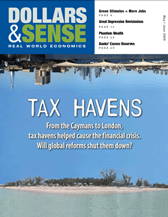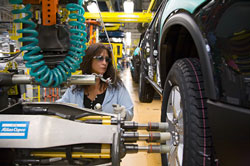Changing the Auto Industry from the Wheels Up
The problems of the U.S. auto industry call for radical solutions.
This is a web-only article from the website of Dollars & Sense: The Magazine of Economic Justice available at http://www.dollarsandsense.org

This is a web-only article, available only at www.dollarsandsense.org.
Subscribe Now
at a 30% discount.
Intro | Pt. I | Pt. II | Pt. III | Pt. IV | Pt. V | Pt. VI | Full article

Photo by Jim West
Part IV: Replacing the “Private Welfare State”
The “private welfare state”—the system under which benefits like health insurance and pensions are provided mostly by private companies—is failing, and the only solution is comprehensive health and pension reform (including a national health-care system).
Since the Second World War, many large U.S. companies have provided benefits, such as pensions and health insurance, provided by the state in other rich capitalist countries. Under this system, sometimes known as the “private welfare state,” individuals enjoy pension and health benefits by virtue of employment at a company that offers them, not as a social right. The auto industry was one of the first to offer such benefits on a large scale (during the Second World War, as a way to get around the wartime wage freeze), and these benefits grew to be very extensive in the course of the postwar period. By the 1960s, they included health coverage for retirees as well as current workers. [Note 46]
The UAW’s objective in pushing for these benefits, especially health benefits, was not only economic, but also political. Walter Reuther, the head of the UAW in the 1940s, believed that imposing health-care costs on employers would push the companies to support a government health-care system, and so help to usher in such a system here. [Note 47] Obviously, that has not happened, to the detriment not only of the tens of millions left uninsured or underinsured, but even of the companies paying for such benefits. The growth of the private welfare state has resulted, for the auto companies and for other employers with long-standing retiree pension and health benefits, in enormous “legacy costs.” For every $55 in current labor costs, for example, Ford pays $16 in retiree pension and health benefits. [Note 48]
Workers at each of the Big Three have made major concessions on retiree health-care obligations. In February, the UAW agreed to accept Ford stock in exchange for about half of the $13.6 billion the company owes a retiree health-care trust. [Note 49] Under GM’s restructuring plan, a retiree health-care trust would receive 39% of the stock in the company. The UAW agreed to cancel about $10 billion in retiree health-care obligations, half of the total the company currently owes the trust, in exchange for this stake in the company. [Note 50] The trust has in effect forgiven $10 billion in debt for less than half of a company that, right now, is worth about $1 billion. Of course, the stock could end up being worth more (or less) in the future.
Under Chrysler’s restructuring, the UAW has accepted, in lieu of $10.6 billion in retiree health obligations (contributions owed by the company to a retiree health-care trust), $4.6 billion as a company IOU plus 55% of the stock in the restructured company. The total value of the deal was put at $8.8 billion, with the stock being valued at $4.2 billion. [Note 51] Since Chrysler is not a publicly traded company, however, it is unclear what the stock is actually worth—that is, what the trust will be able to sell the stock for when it needs cash to pay out benefits. Two years ago, the venture-capital firm Cerberus paid Daimler $7.4 billion for 80% of Chrysler’s stock, but $6 billion of that was retained by Chrysler and its financial arm (both controlled by Cerberus after the sale), and only $1.4 billion actually went to Daimler. [Note 52] Cerberus’ $6 billion investment in Chrysler was worth something to Daimler, since it increased the value of the 20% of Chrysler that Daimler still owned. However, the terms of the deal do not suggest that the company was worth over $9 billion then, as some commentators have estimated. [Note 53] It is possible, then, that the trust’s stake in Chrysler is worth less—perhaps much less—than $4.2 billion. Meanwhile, in the event that this stake ends up being worth more than $4.2 billion, under the terms of the plan the balance would go not to the trust but to the U.S. Treasury. [Note 54] Finally, the deal exposes retirees to additional risk since the viability of the company remains in doubt, and stock holders are last in line to be paid in the event of bankruptcy.
The auto companies signed collective-bargaining agreements promising auto workers pension and health benefits. Current and former employees have a special contractual claim on these companies for the benefits they have been promised, and should not be left without health or pension protections. (Pension benefits are insured by the government’s Pension Benefit Guaranty Corporation, though in the event that any of the auto companies defaulted on their pension obligations, workers would likely get much lower pensions that they had been promised. [Note 55]) In the grand scheme, however, all workers—whether or not they have enjoyed the good fortune of being employed by companies that offer retirement and health benefits—have a moral claim to a comfortable retirement and access to medical care.
The failings of the private welfare state scream out for a comprehensive reform, rather than a “fix” that applies only to this or that category of workers. This system leaves tens of millions of people without health coverage. (The Centers for Disease Control reported that over 50 million people in the United States lacked coverage at some point during 2006. [Note 56]) Workers with health problems are afraid to change jobs, due to the danger of losing their health insurance. Workers who lose their jobs face the catastrophe of losing health coverage, as is now happening to millions of workers. (The Center for American Progress reports that over 2 million U.S. workers have lost coverage due to unemployment during the current recession. [Note 57]) The private welfare state, moreover, contributes to enormous administrative costs resulting from the existence of so many different health insurance plans. It narrows the pools of individuals across which risk is spread, and so makes the cost of insurance greater.
A comprehensive solution to this crisis requires the creation of a national health-care system and the revision of the public pension system to make it much more redistributive. The “private welfare state” should be replaced by a system that treats health-care and retirement benefits as economic rights, takes these factors “out of competition” for workers (so workers will not have to sacrifice retirement or health benefits to save their jobs), and broadly spreads risk across the entire society.
Intro | Pt. I | Pt. II | Pt. III | Pt. IV | Pt. V | Pt. VI | Full article
End Notes:
46. Ron French, World War II created health insurance perk, Detroit News, October 25, 2006.
47. Bill Koenig, UAW Chief Faces Reuther Legacy, ‘Crashing’ Industry, Bloomberg.com, July 20, 2007.
48. David Leonhardt, $73 an Hour: Adding it Up (Figuring Autoworkers’ Pay), New York Times, December 10, 2008.
49. Nick Bunkley, U.A.W. Agrees to Concessions at Ford, New York Times, February 23, 2009.
50. John D. Stoll and Sharon Terlep, GM Offers U.S. a Majority Stake, Wall Street Journal, April 28, 2009; John D. Stoll and Sharon Terlep, Plan Sees a Smaller, Focused—and Profitable—GM, Wall Street Journal, April 28, 2009.
51. John Lippert and Mike Ramsey, UAW Said to Get 55% Chrysler Ownership, Board Seats, Bloomberg, April 28, 2009.
52. Chris Isidore, Daimler pays to dump Chrysler, CNNMoney, May 14, 2007.
53. Doug Henwood, The UAW’s Chrysler Stake: How 55% = 0%, LBO News.
54. Doug Henwood, The UAW’s Chrysler Stake: How 55% = 0%, LBO News.
55. Mary Williams Walsh, Plight of Carmakers Could Upset All Pension Plans, New York Times, April 23, 2009.
56. Robin A. Cohen, Ph.D., and Michael E. Martinez, M.P.H., Health Insurance Coverage: Early Release of Estimates from the National Health Interview Survey, January—September 2006, Division of Health Interview Statistics, National Center for Health Statistics, Centers for Disease Control.
57. Nayla Kazzi, More Americans are Losing Health Insurance Every Day, Center for American Progress, May 4, 2009.
Did you find this article useful? Please consider supporting our work by donating or subscribing.
